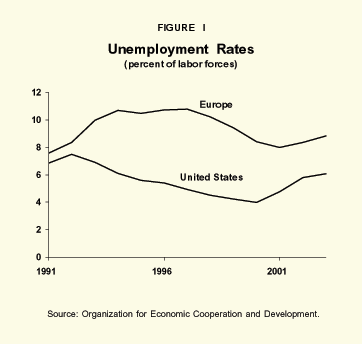
Europe is a great place to visit – but don't try to find a job there. Unemployment averaged 8.8 percent in Europe last year, compared to 6.1 percent in the United States. [See Figure I.] Americans have been disappointed with a weak labor market in the last few years, but put this into perspective: Over the last 12 years, America's worst unemployment rate was better than Europe's best unemployment rate.
Unemployment Lasts Longer in Europe than in the United States. In the recent economic downturn, Americans have been concerned with the length of time it takes unemployed people to find new work. Although our own performance is less than we could – and should – strive for, it is better than Europe's by a country kilometer. Figure II shows how long people spent looking for work in different countries in 2002, the most recent year for which data is available for all of them. (The duration of unemployment was generally higher in 2003, when, for example, the U.S. average duration rose to 4.4 months.) What's wrong with Europe? Why should it take so long to find work in such developed countries as France or Switzerland? There are a number of reasons for Europe's disappointing performance.

More Generous Benefits. First, unemployment insurance benefits are more generous in Europe than in the United States. The "replacement rate," the portion of previous income replaced by unemployment insurance benefits, is generally much higher there. According to a study by the Organization for Economic Cooperation and Development (OECD):
- Although lower-wage American workers often receive 50 percent of their former wages, the replacement rate is much lower for high-income workers because of ceilings on benefits.
- Thus, in the United States, unemployment benefits replaced an average of 25 percent to 29 percent of a worker's wages in 1995.
- In comparison, benefits are a much higher percentage of former earnings in a number of European countries, including Belgium (51 percent), France (58 percent), Switzerland (70 percent) and Denmark (71 percent).
The impetus to find another job falls as replacement rates rise.
More Months of Benefits. A second factor in Europe's high unemployment rates is the long period of time for which benefits are paid. Unemployment insurance benefits in the United States typically are exhausted after six months. However, a number of European countries pay over 40 percent of previous wages in the second and third year of unemployment. A few countries keep the benefits flowing even into the fourth and fifth years of unemployment.
Long eligibility periods encourage workers to delay their job search efforts until their unemployment benefits are about to run out. Note also the one country with a shorter duration of unemployment than ours: In Mexico, dismissed workers are entitled to a lump-sum payment from their former employer, but the worker does not have to remain unemployed to receive this benefit.
Wage Inflexibility. A third factor hurting European workers is wage inflexibility. In the United States, wage growth is depressed in recessions. When wage growth slows, the number of workers hired increases. Wages tend to be more rigid in Europe, where they are often set by union bargaining with an entire industry. As a result, wage growth does not slow when labor is in surplus, thus limiting the demand for additional workers.
High Costs of Employment. Finally, no discussion of European unemployment is complete without mentioning employment protection. Europeans dislike layoffs, and they make it very costly for companies to dismiss workers. The result is actually harmful to the unemployed. Because it is so expensive for a company to terminate an employee, firms are very hesitant to hire workers in the first place. In contrast, American companies test the market by expanding their work forces. If the expansion doesn't work out, employees are let go. It sounds ruthless, but it has resulted in stronger employment growth in the United States than in Europe.
Which is quantitatively the greatest factor? Economist Stephen Nickell surveyed the research on European unemployment. He concluded that the greatest effects on unemployment come from "…generous unemployment benefits that are allowed to run on indefinitely, combined with little or no pressure on the unemployed to obtain work and low levels of active intervention to increase the ability and willingness of the unemployed to work."
Conclusion. America can take some lessons from the European experience. Unemployment insurance benefits must be accompanied by a strong work-search expectation. Rapid reemployment is best for the unemployed person, and best for the economy as a whole. The worst case scenario would be for states to increase unemployment benefits – or Congress to extend them once again – while reducing the expectation that recipients go out and find work.
Bill Conerly is a senior fellow with the National Center for Policy Analysis and an economic consultant. He can be reached at Bill@ConerlyConsulting.com.